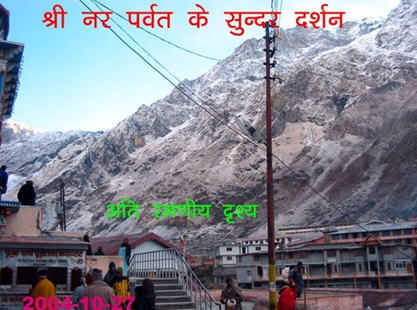Near the temple are a number of kunds filled with hot sulfur water. Pilgrims bathe in the kunds before taking darshan in the temple. Each hot spring is a different temperature and some are very very hot.

Before entering the temple it is customary for one to bathe in Tapta Kund, which is a hot water tank at the base of the temple steps near the river. The temperature is around 45°C (115°F). Narada Kund is where Adi Sankaracharya recovered the murti of Sri Badri Vishal. It is a small kund a few feet from the Alakananda River, on the temple side of the Alakananda.
Panch Shilas-Narada, Narasimha, Varaha, Garuda, and Markandeya-are located by Tapta Kund. These are large rocks near the river.
If you climb 200m (650 ft) u can visit the placecalled Deva Darshini. From here it is said the demigods come to have darshan of the holy town of Badrinath
. 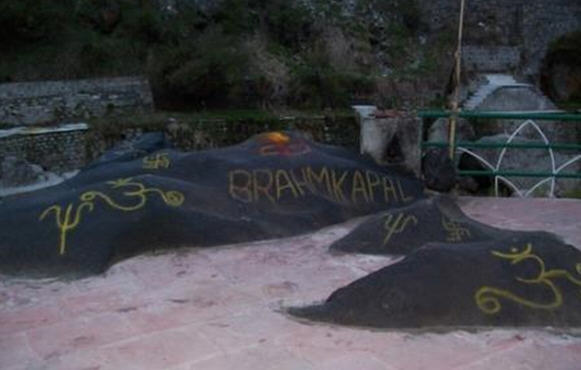
About 100m north of the Badrinath Temple, on the bank of the Alakananda, is Brahma Kapal Ghat. It is customary to offer pinda (sraddha) to departed ancestors here. When Lord Siva in the form of Bhairava cut off Lord Brahma’s fifth head, it is said to have fallen here at Brahma Kapal.
In The Area near Keshava Prayag there is a temple dedicated to Mata Murti, mother of Nara and Narayana Rishi. Near the temple is a mountain called Maninag Parvat. It is said that near this mountain, Yudhisthira was able to answer all the questions asked by Yamaraja as yaksha in order to bring his brothers back to life. They lost their lives when they did not answer the questions.
And there is a boulder at Charan- paduka, two kilometers away, that has the footprints of Lord Vishnu. This is where He stepped when He once descended to earth.
Pancha Dhara (five Waterfalls) : Kurma,Prahlada, Urvasi, Bhrigu, and Indra are waterfalls all located around Badrinath
. 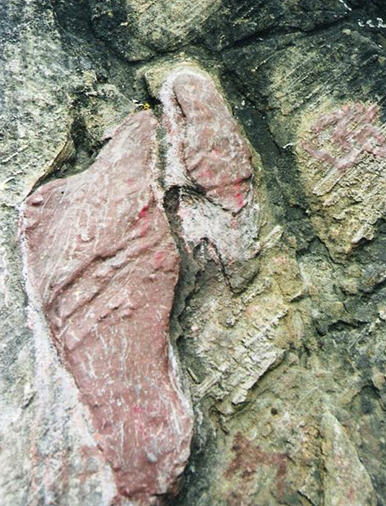
Sesha Netra is a large stone marked with one eye of Ananta Shesha, who is watching over everyone.
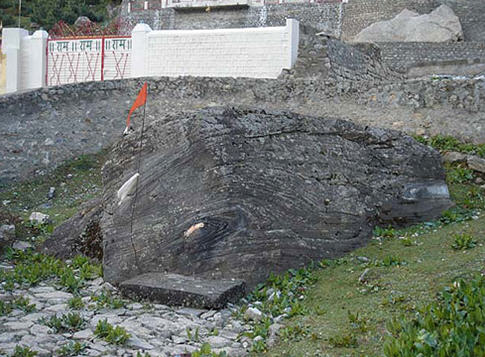
Urvasi Temple is where Indra’s pride was shattered by Urvasi, the most beautiful Apsara
. 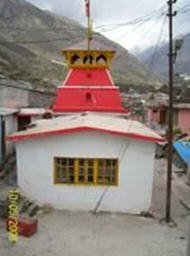
Nara and Narayana Mountains: Nara Parvat is opposite the main temple, and Narayana Parvat is behind. They are named after Nara and Narayana Rishis who did meditation here. Neelkantha Peak (6,596m/21,635 ft), is to the left of Narayana Parvat. It changes color at sunrise and sunset. It is called the “Queen of the Himalayas” or the “shining pyramid.”
c)Mana
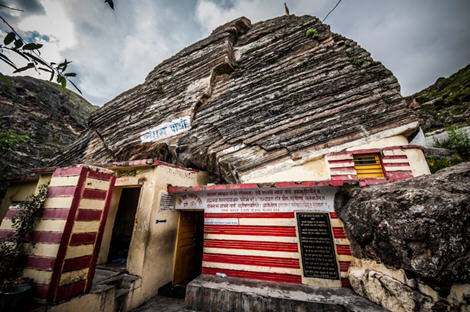
Mana is 4 km northwest of Badrinath near the Tibet border. This is where Vyasadeva’s cave is located. He is said to have divided the Vedas into four parts and compiled many Puranas here. The front of the cave is painted white, and there is a deity of Vyasadeva in the cave. Nearby is Ganesh’s cave where Ganeshji sat and scribed down all Vedas spoken by Vyasaadev. There are rocks here that look like layers of paper and are said to represent his works of writing down the Mahabharata and Srimad Bhagavatam. Vyasadeva narrated these works, and Ganesh wrote them down, under the condition that Vyasadeva would not stop reciting.
Near this location, Lord Siva narrated the glories of the Himalayas to the sage Skanda, who wrote the Skanda Purana.


The Bhima and Mucukund caves are located just above the cave of Vyasadeva. Down below is Bhima Pul (Bhima’s bridge), which Bhima is said to have made from a huge stone slab, so his brothers and Draupadi could cross the Saraswati River safely
. 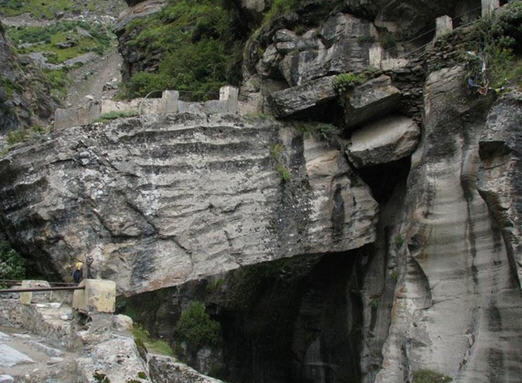
The Saraswati River emerges from a glacier north of Mana, touches Vyasa Gupha, and then merges into the river Alakananda at nearby Keshav Prayag . About three km from Bhima Pul is Vasudhara Falls,
which are more than 44m (135 ft) high.
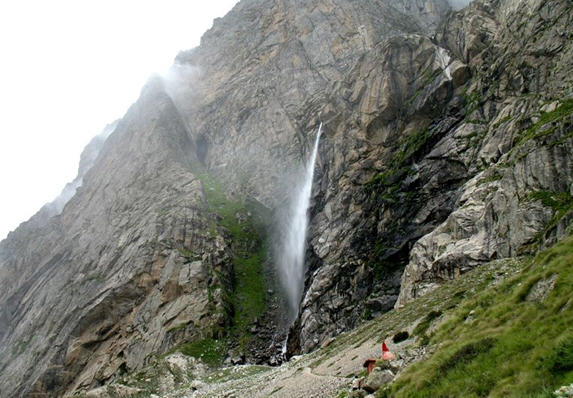
d) Satopanth Lake
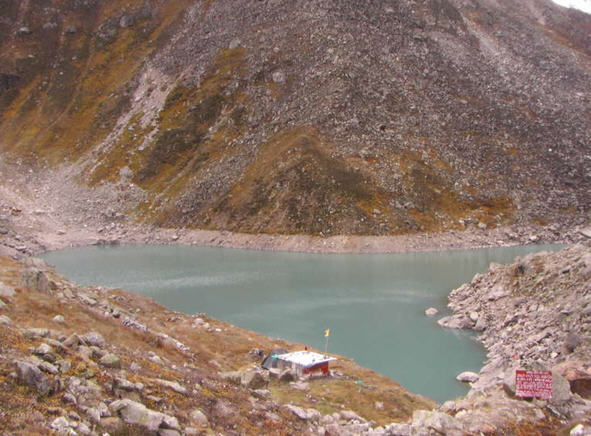
At Satopanth (4,402m/14,442 ft), is the Lake of the Divine Trinity, a glacial lake. It is 25km from Badrinath. Lord Brahma, Lord Siva, and Lord Vishnu are said to meditate at the three corners of this crystal clear, green-water lake. On Ekadasi, Lord Vishnu is said to come and take bath here.
Satopanth Lake is in a restricted area. To get here you walk past Mana. After leaving Mana you walk across a meadow full of flowers before reaching the 44m Vasudhara Falls. The path becomes more difficult until you reach the source of the Alakananda river, which is near where the Bhagirath Kharak and Satopanth glaciers meet. You then walk across the Chakra Tirtha meadow and over the steep rise of the glacier to get to Satopanth Lake. At this point you are surrounded by the mountains Swargarohini (7.898m), Chaukhamba (7,164m), and Neelkanth (6,558m), which make a sensational sight.
e) Beyond Mana
At Laksmivan, Lakshmi is said to have meditated in a forest of Bhoj Patra trees.
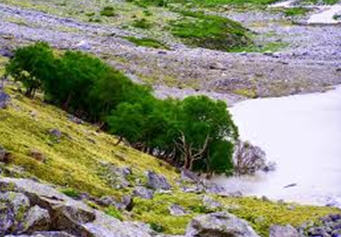
Cakra-tirtha is where Arjuna is said to have taken bath and received Lord Siva’s Pashupati Astra, which helped him defeat the Kauravas in Battle of Kurukshetra. Swargarohan Mountain (Stairway to Heaven) is said to be where the Pandavas, after visiting Badrinath, ascended to the spiritual world.
